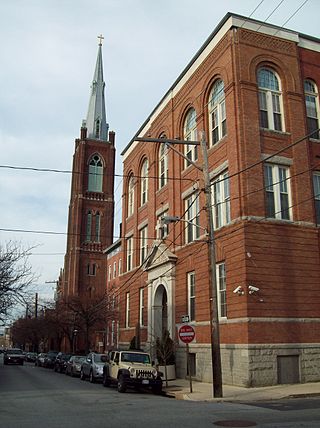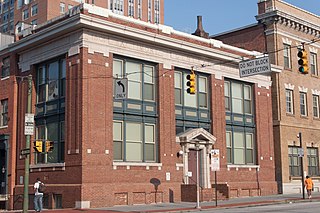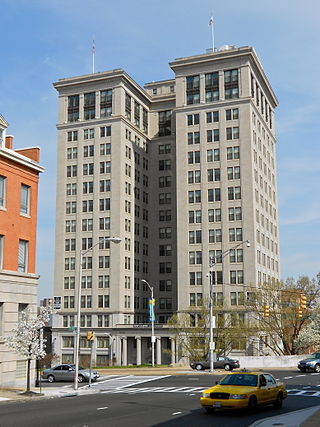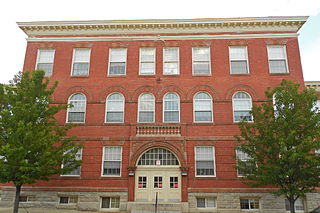
Bolton Hill is a neighborhood in Baltimore, Maryland, with 20 blocks of mostly preserved buildings from the late 19th century. It is listed on the National Register of Historic Places, preserved as a Baltimore City Historic District, and included within the boundaries of Baltimore National Heritage Area. The neighborhood is bounded by North Avenue, Mount Royal Avenue, Cathedral Street, Dolphin Street, and Eutaw Place. Bolton Hill is a largely residential neighborhood with three-story row houses with red brick, white marble steps, and high ceilings. There are also larger more ornate originally single-family houses, many houses of worship, parks, monuments, and a few large apartment buildings. Many significant residents have lived in the neighborhood, including F. Scott Fitzgerald, Woodrow Wilson, the Cone sisters, and Florence Rena Sabin.

Homeland is a neighborhood in the northern part of Baltimore, Maryland, United States. It is bounded roughly by Melrose Avenue on the north, Bellona Avenue on the east, Homeland Avenue on the south, and Charles Street on the west.

Mount Clare, also known as Mount Clare Mansion and generally known today as the Mount Clare Museum House, is the oldest Colonial-era structure in the City of Baltimore, Maryland, U.S.A. The Georgian style of architecture plantation house exhibits a somewhat altered five-part plan. It was built on a Carroll family plantation beginning in 1763 by barrister Charles Carroll the Barrister, (1723–1783), a descendant of the last Gaelic Lords of Éile in Ireland and a distant relative of the much better-known Charles Carroll of Carrollton, (1737–1832), longest living signer of the Declaration of Independence and the richest man in America in his later years, also the layer of the First Stone of the new Baltimore and Ohio Railroad, just a short distance away in 1828.

The Elkridge Furnace Complex is a historic iron works located on approximately 16 acres (6.5 ha) at Elkridge, Howard County, Maryland.

University of Maryland Rehabilitation & Orthopaedic Institute is a rehabilitation hospital located along the border of the Forest Park neighborhood of northwest Baltimore City and Woodlawn in Maryland. It lies on and is incorporated into the historic hospital building and grounds of the former James Lawrence Kernan Hospital. The hospital is now part of the University of Maryland Medical System, on the campus of the University of Maryland at Baltimore.

St. Elizabeth of Hungary is a historic Roman Catholic church complex located within the Archdiocese of Baltimore in the Baltimore-Linwood neighborhood of Baltimore, Maryland, United States.

Holy Cross Roman Catholic Church is a historic Roman Catholic church complex located within the Archdiocese of Baltimore in the Federal Hill neighborhood of Baltimore, Maryland, United States.

Northern District Police Station is a historic police station located at Baltimore, Maryland, United States. It is a complex of interconnected buildings designed in the late Victorian/French Renaissance style consisting of a three-story main station house with a hipped roof and dormers; a connected two story building which had originally housed the cellblock; and a pair of hipped roof garages which were originally used as livery buildings. They are in turn connected to an L-shaped building consisting of the original clerestoried stable and flat roofed garage. The buildings encircle a courtyard which is now used as a parking lot. It was designed by Henry F. Brauns in 1899.

Baltimore General Dispensary is a historic public dispensary building located at Baltimore, Maryland, United States. It opened in 1801 to provide medical and health services to the poor in Baltimore. It is the oldest institution of its kind in Maryland. It is three bays wide and two stories high, with running bond red brick foundation and building walls, and a water table constructed in 1911. The front features a simple cornice surmounting a stone entablature reading: 1801 Baltimore General Dispensary 1911. It is the only surviving building designed for Baltimore's oldest charity. The interior originally featured a large dispensary center on the first floor, separated for black and white patients. The rooms for surgical and medical aid on the second floor gave the poor a measure of privacy rarely available to charity patients.

Standard Oil Building, also known as the Stanbalt Building, is a historic office building located at Baltimore, Maryland, United States. It is a 15-story Beaux Arts skyscraper designed by Clyde N. Friz (1867-1942), one of Baltimore's best-known Beaux Arts designers, and built in 1922. The steel-frame U-shaped office building is clad in limestone. It was built by the Standard Oil Company at a time when that business was once one of the nation's principal corporations, the dominant supplier of gasoline and fuels.

G. Krug & Son Ironworks is a historic iron works located at Baltimore, Maryland, United States. It is a complex consisting of a two-story tall gable-roofed building dating from the first quarter of the 19th century, which houses the earliest shop; a four-story tall Victorian building which houses a business office on the first floor and storage rooms on the upper floors; and a three-story tall shed-roofed addition dating from 1870 to 1880. It is in its fifth generation as a family business.

Coca-Cola Baltimore Branch Factory is a historic factory complex located at Baltimore, Maryland, United States. It was constructed from 1921 to 1948 and built principally to house Coca-Cola's syrup-making operations. The complex is spread over a 9.4-acre (38,000 m2) site and includes a two-story brick syrup factory/sugar warehouse and an earlier two-story brick mattress factory that Coca-Cola acquired and adapted in the 1930s. Completed in 1948, the complex housed syrup-making operations as well as the Coca-Cola Company's chemistry department.

National Enameling and Stamping Company is a historic factory complex located at Baltimore, Maryland, United States. It was constructed in 1887 to serve as the works of the Baltimore branch of the nation's largest tinware manufacturer, the National Enameling and Stamping Company (NESCO). The densely packed complex fills an almost 5-acre (2.0 ha) site and consists of 17 interconnected buildings and one structure that vary in height from one to five stories. The complex was organized to house three primary functions in discrete sections: the manufacture of tinware, the manufacture of enameled and japanned wares, and storage, warehousing, and distribution. The plant ceased production of tinware and enameled wares in 1952.

Equitable Gas Works is a historic gas works located at Baltimore, Maryland, United States. It is a U-shaped complex occupying an entire city block and consisting of five 1882-1883 Romanesque Revival painted brick buildings ranging from one to two stories in height and one 1947 office building adjacent to CSX tracks in Spring Gardens, an industrial precinct in South Baltimore, Maryland.

Montgomery Ward Warehouse and Retail Store is a historic warehouse and retail building in Baltimore, Maryland, United States. It is an eight-story concrete structure and is roughly shaped like a squared-off number "4". The front features a penthouse tower at the main entrance bay with a balcony and capped by a flagpole. The building houses over 1,200,000 square feet (110,000 m2) of floor space flooded by light from approximately 1,000 large multi-paned, steel frame windows. It was built about 1925 as a mail order and retail warehouse for Montgomery Ward on an 11 acres (4.5 ha) site adjacent to the Baltimore and Ohio Railroad tracks. The complex was one of nine large warehouses built by the company in the United States.

The Loft Historic District South is a national historic district in Baltimore, Maryland, United States. It includes seven large brick manufacturing buildings on both sides of the 500 block of West Pratt Street near the University of Maryland campus in downtown Baltimore. Of the seven buildings, four have been converted into a loft apartment building complex known as the Greenehouse. The district includes the Sonneborn Building.

Stone Hill Historic District is a national historic district in Baltimore, Maryland, United States. It is one of the original mill villages along the Jones Falls, having been developed circa 1845–1847 to house textile mill workers. Comprising seven blocks, the district includes 21 granite duplexes, a granite Superintendent's House, and a granite service building – all owned by Mount Vernon Mills from 1845 to 1925.

Franklin Square Historic District is a national historic district in Baltimore, Maryland, United States. It is a 19th-century rowhouse neighborhood developed along a strict grid street pattern. A one square block, two and a half acre public park, Franklin Square, is a focal point for the area and the most elaborate rowhousing surrounds the square. The district contains approximately 1,300 buildings of which approximately 1,250 contribute to the significance of the historic district.

Franklintown Historic District is a national historic district in Baltimore, Maryland, United States. It is the result of a plan developed in 1832 by William H. Freeman (1790–1863), a local politician and entrepreneur. His plan evolved gradually over the course of several decades and owes its success to his untiring promotion of the village. The central feature is an oval plan with radiating lots around a central wooded park. The district includes an old stone grist mill known as Franklin Mill, the innovative radiating oval plan, and the associated hotel and commercial area. The key residential buildings are excellent examples of the "I"-house form and display steeply pitched cross gables found in vernacular rural buildings throughout much of Maryland.

Winters Lane Historic District is a national historic district at Catonsville, Baltimore County, Maryland, United States. It is a historically African-American residential community which developed between 1867 and the mid-1940s. Winters Lane is located between Frederick Road and the Baltimore National Pike. It is composed mainly of single-family dwellings augmented by a few commercial, social, or religious resources. The district contains 155 properties, including 141 residential properties, two former schools, three commercial buildings, three social clubs, and five churches or church-related buildings.

























